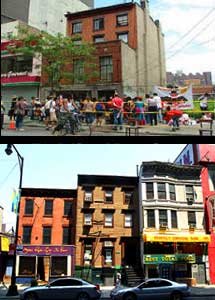On January 7, 2004, Joy Chatel, an owner of 227 Duffield Street was given a notice informing her that her home would be taken by eminent domain and demolished to make way for a new parking lot. Many believe that her home was a station on the Underground Railroad and a vital cultural treasure that should be preserved. The Underground Railroad was the network of people and places in which fugitive slaves sought refuge when escaping from the plantation system in the South.
The home, built in 1848, was owned by Thomas and Harriet Lee-Truesdell, prominent abolitionists of that era. Their role in the abolitionist movement, coupled with their relationships with other active abolitionists in Downtown Brooklyn, led the City’s own researchers to conclude that the property was “quite possibly” linked to the Underground Railroad and the majority of historians commissioned by the City to review its research advocated for the home’s preservation. Despite this historical documentation and the presence of several unexplainable architectural abnormalities in the sub-basements from 227-235 Duffield St, the City of New York initially concluded that the home’s historic significance did not warrant its preservation. In response to litigation and years of advocacy on the part of those who support preserving the property, the City has agreed to re-draw its plans for Downtown Brooklyn so that the condemnation of 227 Duffield will not be necessary.
“I want to thank the Mayor for listening to our plea,” Joy Chatel, an owner of 227 Duffield Street said, “My vision is to continue the Cultural Center and Museum my daughter and I started years ago; so all people home and abroad can benefit from the rich history downtown Brooklyn has to offer. I am also thankful to the many people who have gone to great lengths to make sure that this vision comes to fruition.”
“So many of us in the community did not want to see the Underground Railroad become an underground parking lot,” said Randy Leigh, area resident and FUREE board member. “Too much of our history has already been lost, and we know the City did the right thing by listening to the community and protecting our history. “
The suit was brought by Jennifer Levy of South Brooklyn Legal Services who says: “I commend the City for their flexibility. They have shown that it is possible to do development thoughtfully, in a manner that is responsive to community concerns, and with an eye to preserving our history.”
Tours of the home will be given on request.
More information will be available at the press conference on Monday, December 3, 2007, 12 PM.
Where: 227 Duffield Street (between Fulton & Willoughby Streets in Brooklyn)
Invited Speakers: Councilmembers Charles Barron, Letitia James, Tony Avella, John Liu; Assembly Member Hakeem Jeffries, State Senator Velmanette Montgomery, US Congressional Representative Yvette Clarke, Assembly Representative Joseph Lentol; Rev. Clinton Miller, Rev. Dyson, Joy Chatel, Families United For Racial and Economic Equality, Jennifer Levy Esq., Four Borough Neighborhood Preservation Alliance, Lewis Greenstein, Raul Rothblatt, Christabel Gough, Jim Driscoll, Richard Hourahan, and others.







